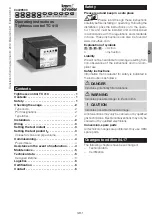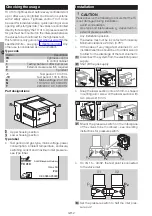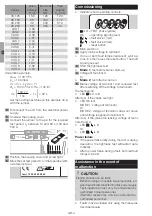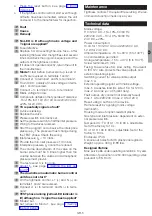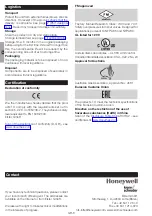
GB-4
D
GB
F
NL
I
E
Valves
Valve
volume
V
V
[l]
Nominal
size
DN
Pipe
volume
V
R
[l/m]
VK 125
13.6
125
12.3
VK 150
20
150
17.7
VK 200
42
200
31.4
VK 250
66
250
49
VAS 1
0.08
VAS 2
0.32
VAS 3
0.68
VAS 6
1.37
VAS 7
2.04
VAS 8
3.34
VAS 9
5.41
VCS 1
0.05
VCS 2
0.18
VCS 3
0.39
VCS 6
1.11
VCS 7
1.40
VCS 8
2.82
VCS 9
4.34
Calculation example:
Q
max.
= 100 m
3
/h
p
u
= 100 mbar
V
P
= V
V
+ L x V
R
= 7 l
Q
L
= 100 m
3
/h x 0.1% = 100 l/h
4 x
(
100 x 7
+ 1 s
)
= 32 s
100
Set the next highest value (in this example 40 s)
with the jumper.
Disconnect the unit from the electrical power
supply.
Unscrew the housing cover.
4
Connect the jumper to the pin for the required
test period t
P
between 10 and 60 s (100 and
600 s).
V2
V1
L1(+)
N(-)
ϑ
max
N
1 2
1 2
"TEST
:
"
TEST"
:"
5
Position the housing cover and screw tight.
6
Mark the set test period t
P
on the type label with
a waterproof pen.
TC
CE-0085AP0020
tp(s) 10 20 30 40 50 60
D-49018 Osnabrück, Germany
Commissioning
▷
Indicators and operating controls:
TEST OK
1
2
TEST
= TEST phase (yellow)
OK
= operating signal (green)
1
= fault valve 1 (red)
2
= fault valve 2 (red)
= reset button
Main switch on.
Apply mains voltage to terminal 1.
▷
If one or both fault lamps (red) are lit, wait ap-
prox. 5 s then press the reset button. The fault
signal goes out.
Start the tightness test.
▷
Mode
, test before burner start-up.
4
Voltage at terminal 3.
Or
▷
Mode
, test after burner run.
5
Mains voltage at terminal 1 and renewed test
after switching off the voltage to terminal 3.
The test begins:
▷
LED
TEST
is lit.
After test, if the valves are tight:
▷
LED
OK
is lit.
MODE 1: voltage at terminal 4.
Or
MODE 2: voltage at terminal 4 does not arrive
until voltage is applied to terminal 3.
After test, if the valves are leaking: voltage at termi-
nals 8 and 9.
▷
LED
1
is lit.
Or
▷
LED
2
is lit.
Power failure
▷
If the power fails briefly during the test or during
operation, the tightness test will restart auto-
matically.
▷
After a power failure during a fault, both red fault
lamps will be lit.
Assistance in the event of
malfunction
CAUTION
Electric shocks can be fatal!
– Before working on possible live components, en-
sure the unit is disconnected from the power supply.
– Fault-clearance must only be undertaken by
authorized trained personnel.
– (Remote) resets may only be conducted by
authorized personnel.
▷
Faults may be cleared only using the measures
described below.

